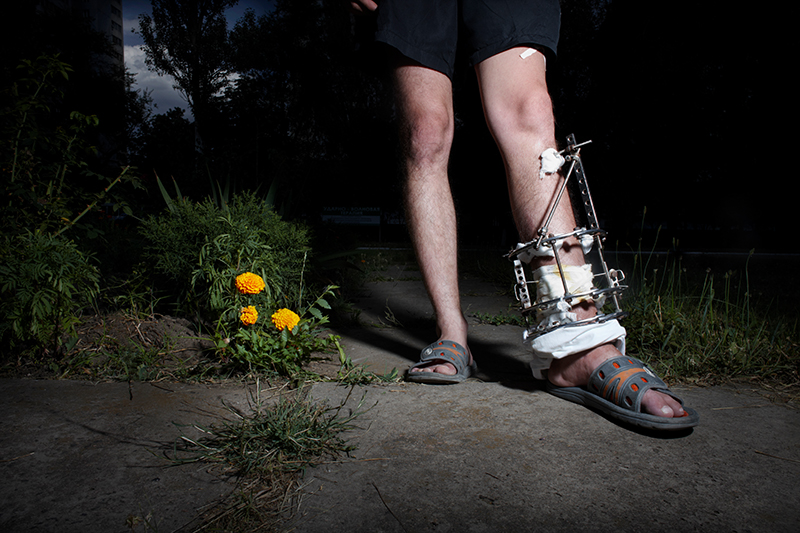
STATEMENT by curator Victoria Ivanova
FRACTURE & HEALING
Despite the need to question first impressions, the instinctive reaction at the face of a new encounter may reveal what an invested gaze may suppress. Ansett’s immediate response to Donetsk was that he arrived to “a city caught in a flux between the lingering hangover of the Soviet past and the seduction of the mythology of Europe’s free market.” Building on his existing interest in the rise of individualism in societies whose appetites have started to exceed common sense, the artist states that ironically what he misses most within his own society is what Ukraine seems to dislike most about itself: “Donetsk should not be too quick to reject completely some of the benefits of an ideology that celebrates the power of the collective” given that a sense of social cohesion and common belonging may be what is needed to move forwards more constructively. Speaking of how this insight is reflected in his Donetsk series, Ansett comments: “The images form a collective – but of individuals existentially placed. This is not a narrative observation of the person – placed in fragmented spaces, it is a further exploration of the isolation brought by the new sense of individualism.”
The placement and arrangement of works in a warehouse that just about escaped destruction in an extensive fire, attempts to reinforce the logic of solitary individuals sharing a seemingly difficult reality which should become the common ground for co-existence. As Richard Ansett points out, “reality is a complex space, we can view the exact same landscape with joy or complete despair but the space remains the same.” One of the halls of Warehouse №2 is transformed to create a church-like atmosphere with luminous images aligned along both sides of the nave leading up to an altar-piece. The sanctuary-feeling encourages solidarity and faith based on the commonality of our experience. The aesthetics of light-boxes alludes to the stained-glass windows in cathedrals through which the light traditionally associated with the divine spirit shines through. Here the luminosity emanates from the flesh of each individual emphasising that the sacred is to be found at the foundation of our being, and in unison we have the power to illuminate and transform what appears as a dark and a hopeless reality.
The six images of individuals with physical injuries taken in the gardens of one of Donetsk’s hospitals make a direct reference to human beings’ inherent fragility. While it is clear that injuries and traumas are inflicted upon us through interaction with the outside world, Ansett conveys that healing can only come from within, as we emerge from denial and understand the power of our agency and internal resources. Ansett explains: “In the hospital gardens, the use of flowers partly represents the fertility of the Ukrainian soil, exploited throughout history by East and West. The subjects here are injured but ultimately full recovery will come only from within Ukraine itself.” The image of a young boy looking straight onto the viewer with a knowledge and wisdom that seem to be beyond his years, and whose physical injury is not immediately obvious.
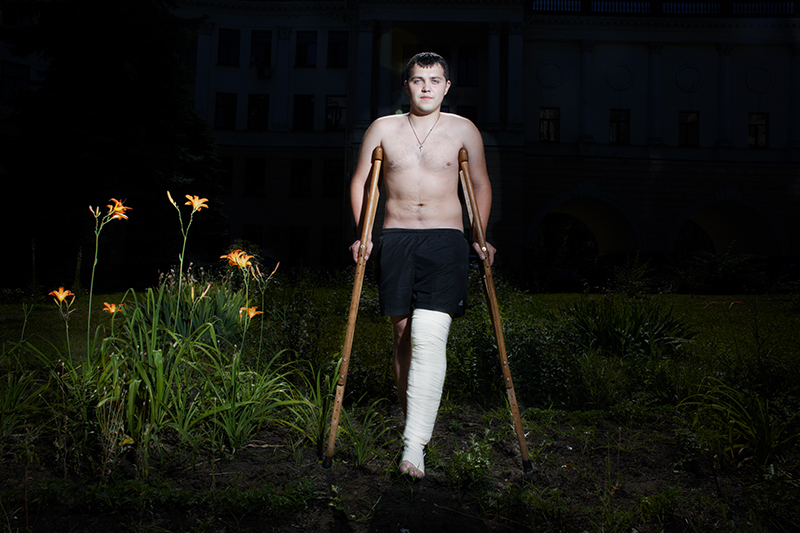
STATEMENT by curator Victoria Ivanova
FRACTURE & HEALING
Despite the need to question first impressions, the instinctive reaction at the face of a new encounter may reveal what an invested gaze may suppress. Ansett’s immediate response to Donetsk was that he arrived to “a city caught in a flux between the lingering hangover of the Soviet past and the seduction of the mythology of Europe’s free market.” Building on his existing interest in the rise of individualism in societies whose appetites have started to exceed common sense, the artist states that ironically what he misses most within his own society is what Ukraine seems to dislike most about itself: “Donetsk should not be too quick to reject completely some of the benefits of an ideology that celebrates the power of the collective” given that a sense of social cohesion and common belonging may be what is needed to move forwards more constructively. Speaking of how this insight is reflected in his Donetsk series, Ansett comments: “The images form a collective – but of individuals existentially placed. This is not a narrative observation of the person – placed in fragmented spaces, it is a further exploration of the isolation brought by the new sense of individualism.”
The placement and arrangement of works in a warehouse that just about escaped destruction in an extensive fire, attempts to reinforce the logic of solitary individuals sharing a seemingly difficult reality which should become the common ground for co-existence. As Richard Ansett points out, “reality is a complex space, we can view the exact same landscape with joy or complete despair but the space remains the same.” One of the halls of Warehouse №2 is transformed to create a church-like atmosphere with luminous images aligned along both sides of the nave leading up to an altar-piece. The sanctuary-feeling encourages solidarity and faith based on the commonality of our experience. The aesthetics of light-boxes alludes to the stained-glass windows in cathedrals through which the light traditionally associated with the divine spirit shines through. Here the luminosity emanates from the flesh of each individual emphasising that the sacred is to be found at the foundation of our being, and in unison we have the power to illuminate and transform what appears as a dark and a hopeless reality.
The six images of individuals with physical injuries taken in the gardens of one of Donetsk’s hospitals make a direct reference to human beings’ inherent fragility. While it is clear that injuries and traumas are inflicted upon us through interaction with the outside world, Ansett conveys that healing can only come from within, as we emerge from denial and understand the power of our agency and internal resources. Ansett explains: “In the hospital gardens, the use of flowers partly represents the fertility of the Ukrainian soil, exploited throughout history by East and West. The subjects here are injured but ultimately full recovery will come only from within Ukraine itself.” The image of a young boy looking straight onto the viewer with a knowledge and wisdom that seem to be beyond his years, and whose physical injury is not immediately obvious.
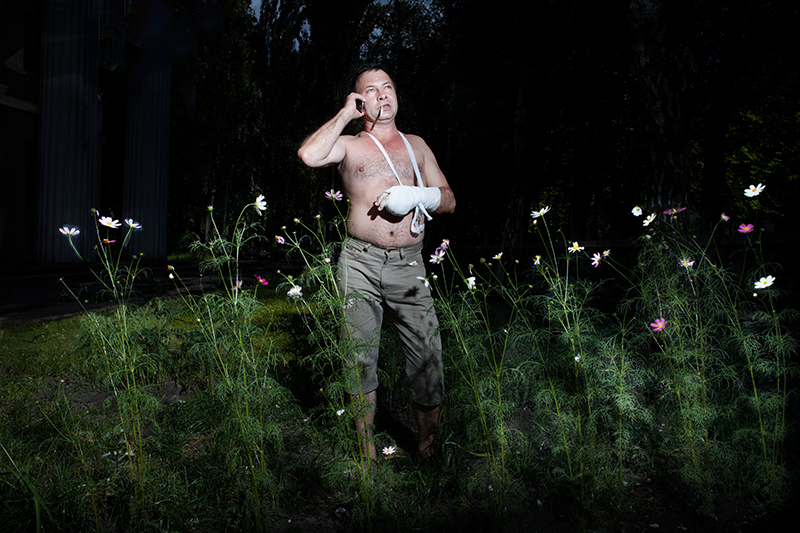
STATEMENT by curator Victoria Ivanova
FRACTURE & HEALING
Despite the need to question first impressions, the instinctive reaction at the face of a new encounter may reveal what an invested gaze may suppress. Ansett’s immediate response to Donetsk was that he arrived to “a city caught in a flux between the lingering hangover of the Soviet past and the seduction of the mythology of Europe’s free market.” Building on his existing interest in the rise of individualism in societies whose appetites have started to exceed common sense, the artist states that ironically what he misses most within his own society is what Ukraine seems to dislike most about itself: “Donetsk should not be too quick to reject completely some of the benefits of an ideology that celebrates the power of the collective” given that a sense of social cohesion and common belonging may be what is needed to move forwards more constructively. Speaking of how this insight is reflected in his Donetsk series, Ansett comments: “The images form a collective – but of individuals existentially placed. This is not a narrative observation of the person – placed in fragmented spaces, it is a further exploration of the isolation brought by the new sense of individualism.”
The placement and arrangement of works in a warehouse that just about escaped destruction in an extensive fire, attempts to reinforce the logic of solitary individuals sharing a seemingly difficult reality which should become the common ground for co-existence. As Richard Ansett points out, “reality is a complex space, we can view the exact same landscape with joy or complete despair but the space remains the same.” One of the halls of Warehouse №2 is transformed to create a church-like atmosphere with luminous images aligned along both sides of the nave leading up to an altar-piece. The sanctuary-feeling encourages solidarity and faith based on the commonality of our experience. The aesthetics of light-boxes alludes to the stained-glass windows in cathedrals through which the light traditionally associated with the divine spirit shines through. Here the luminosity emanates from the flesh of each individual emphasising that the sacred is to be found at the foundation of our being, and in unison we have the power to illuminate and transform what appears as a dark and a hopeless reality.
The six images of individuals with physical injuries taken in the gardens of one of Donetsk’s hospitals make a direct reference to human beings’ inherent fragility. While it is clear that injuries and traumas are inflicted upon us through interaction with the outside world, Ansett conveys that healing can only come from within, as we emerge from denial and understand the power of our agency and internal resources. Ansett explains: “In the hospital gardens, the use of flowers partly represents the fertility of the Ukrainian soil, exploited throughout history by East and West. The subjects here are injured but ultimately full recovery will come only from within Ukraine itself.” The image of a young boy looking straight onto the viewer with a knowledge and wisdom that seem to be beyond his years, and whose physical injury is not immediately obvious.
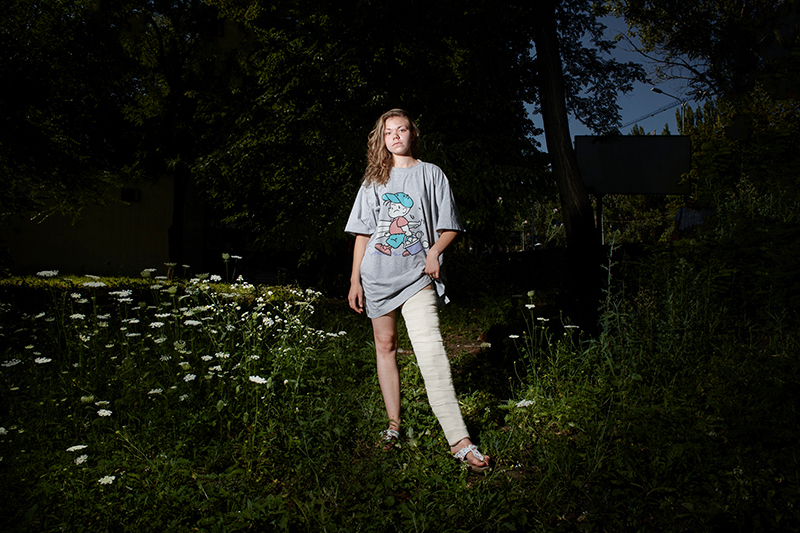
STATEMENT by curator Victoria Ivanova
FRACTURE & HEALING
Despite the need to question first impressions, the instinctive reaction at the face of a new encounter may reveal what an invested gaze may suppress. Ansett’s immediate response to Donetsk was that he arrived to “a city caught in a flux between the lingering hangover of the Soviet past and the seduction of the mythology of Europe’s free market.” Building on his existing interest in the rise of individualism in societies whose appetites have started to exceed common sense, the artist states that ironically what he misses most within his own society is what Ukraine seems to dislike most about itself: “Donetsk should not be too quick to reject completely some of the benefits of an ideology that celebrates the power of the collective” given that a sense of social cohesion and common belonging may be what is needed to move forwards more constructively. Speaking of how this insight is reflected in his Donetsk series, Ansett comments: “The images form a collective – but of individuals existentially placed. This is not a narrative observation of the person – placed in fragmented spaces, it is a further exploration of the isolation brought by the new sense of individualism.”
The placement and arrangement of works in a warehouse that just about escaped destruction in an extensive fire, attempts to reinforce the logic of solitary individuals sharing a seemingly difficult reality which should become the common ground for co-existence. As Richard Ansett points out, “reality is a complex space, we can view the exact same landscape with joy or complete despair but the space remains the same.” One of the halls of Warehouse №2 is transformed to create a church-like atmosphere with luminous images aligned along both sides of the nave leading up to an altar-piece. The sanctuary-feeling encourages solidarity and faith based on the commonality of our experience. The aesthetics of light-boxes alludes to the stained-glass windows in cathedrals through which the light traditionally associated with the divine spirit shines through. Here the luminosity emanates from the flesh of each individual emphasising that the sacred is to be found at the foundation of our being, and in unison we have the power to illuminate and transform what appears as a dark and a hopeless reality.
The six images of individuals with physical injuries taken in the gardens of one of Donetsk’s hospitals make a direct reference to human beings’ inherent fragility. While it is clear that injuries and traumas are inflicted upon us through interaction with the outside world, Ansett conveys that healing can only come from within, as we emerge from denial and understand the power of our agency and internal resources. Ansett explains: “In the hospital gardens, the use of flowers partly represents the fertility of the Ukrainian soil, exploited throughout history by East and West. The subjects here are injured but ultimately full recovery will come only from within Ukraine itself.” The image of a young boy looking straight onto the viewer with a knowledge and wisdom that seem to be beyond his years, and whose physical injury is not immediately obvious.
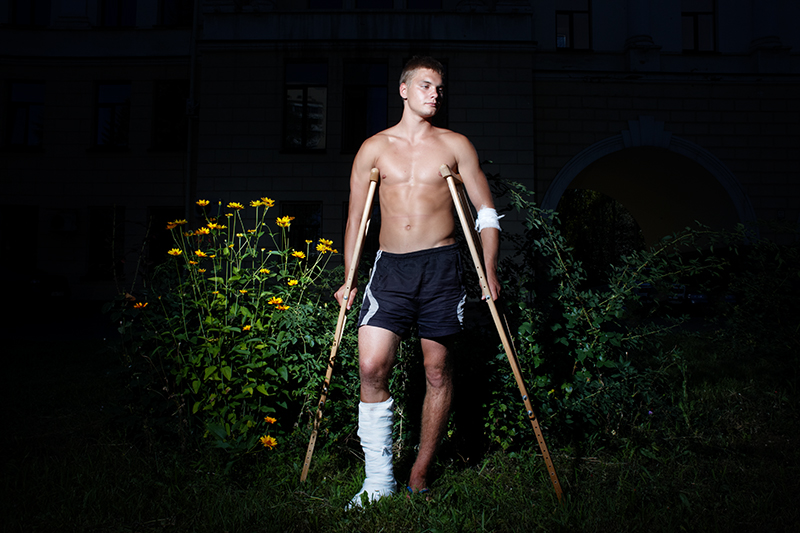
STATEMENT by curator Victoria Ivanova
FRACTURE & HEALING
Despite the need to question first impressions, the instinctive reaction at the face of a new encounter may reveal what an invested gaze may suppress. Ansett’s immediate response to Donetsk was that he arrived to “a city caught in a flux between the lingering hangover of the Soviet past and the seduction of the mythology of Europe’s free market.” Building on his existing interest in the rise of individualism in societies whose appetites have started to exceed common sense, the artist states that ironically what he misses most within his own society is what Ukraine seems to dislike most about itself: “Donetsk should not be too quick to reject completely some of the benefits of an ideology that celebrates the power of the collective” given that a sense of social cohesion and common belonging may be what is needed to move forwards more constructively. Speaking of how this insight is reflected in his Donetsk series, Ansett comments: “The images form a collective – but of individuals existentially placed. This is not a narrative observation of the person – placed in fragmented spaces, it is a further exploration of the isolation brought by the new sense of individualism.”
The placement and arrangement of works in a warehouse that just about escaped destruction in an extensive fire, attempts to reinforce the logic of solitary individuals sharing a seemingly difficult reality which should become the common ground for co-existence. As Richard Ansett points out, “reality is a complex space, we can view the exact same landscape with joy or complete despair but the space remains the same.” One of the halls of Warehouse №2 is transformed to create a church-like atmosphere with luminous images aligned along both sides of the nave leading up to an altar-piece. The sanctuary-feeling encourages solidarity and faith based on the commonality of our experience. The aesthetics of light-boxes alludes to the stained-glass windows in cathedrals through which the light traditionally associated with the divine spirit shines through. Here the luminosity emanates from the flesh of each individual emphasising that the sacred is to be found at the foundation of our being, and in unison we have the power to illuminate and transform what appears as a dark and a hopeless reality.
The six images of individuals with physical injuries taken in the gardens of one of Donetsk’s hospitals make a direct reference to human beings’ inherent fragility. While it is clear that injuries and traumas are inflicted upon us through interaction with the outside world, Ansett conveys that healing can only come from within, as we emerge from denial and understand the power of our agency and internal resources. Ansett explains: “In the hospital gardens, the use of flowers partly represents the fertility of the Ukrainian soil, exploited throughout history by East and West. The subjects here are injured but ultimately full recovery will come only from within Ukraine itself.” The image of a young boy looking straight onto the viewer with a knowledge and wisdom that seem to be beyond his years, and whose physical injury is not immediately obvious.
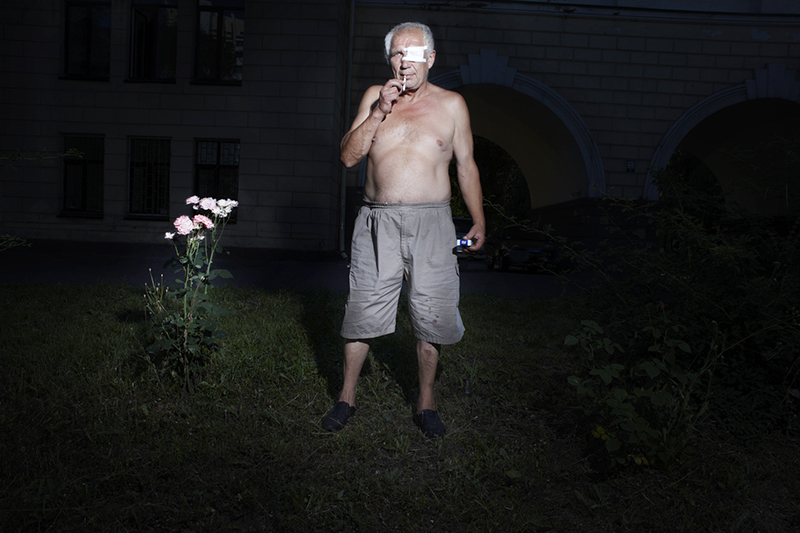
STATEMENT by curator Victoria Ivanova
FRACTURE & HEALING
Despite the need to question first impressions, the instinctive reaction at the face of a new encounter may reveal what an invested gaze may suppress. Ansett’s immediate response to Donetsk was that he arrived to “a city caught in a flux between the lingering hangover of the Soviet past and the seduction of the mythology of Europe’s free market.” Building on his existing interest in the rise of individualism in societies whose appetites have started to exceed common sense, the artist states that ironically what he misses most within his own society is what Ukraine seems to dislike most about itself: “Donetsk should not be too quick to reject completely some of the benefits of an ideology that celebrates the power of the collective” given that a sense of social cohesion and common belonging may be what is needed to move forwards more constructively. Speaking of how this insight is reflected in his Donetsk series, Ansett comments: “The images form a collective – but of individuals existentially placed. This is not a narrative observation of the person – placed in fragmented spaces, it is a further exploration of the isolation brought by the new sense of individualism.”
The placement and arrangement of works in a warehouse that just about escaped destruction in an extensive fire, attempts to reinforce the logic of solitary individuals sharing a seemingly difficult reality which should become the common ground for co-existence. As Richard Ansett points out, “reality is a complex space, we can view the exact same landscape with joy or complete despair but the space remains the same.” One of the halls of Warehouse №2 is transformed to create a church-like atmosphere with luminous images aligned along both sides of the nave leading up to an altar-piece. The sanctuary-feeling encourages solidarity and faith based on the commonality of our experience. The aesthetics of light-boxes alludes to the stained-glass windows in cathedrals through which the light traditionally associated with the divine spirit shines through. Here the luminosity emanates from the flesh of each individual emphasising that the sacred is to be found at the foundation of our being, and in unison we have the power to illuminate and transform what appears as a dark and a hopeless reality.
The six images of individuals with physical injuries taken in the gardens of one of Donetsk’s hospitals make a direct reference to human beings’ inherent fragility. While it is clear that injuries and traumas are inflicted upon us through interaction with the outside world, Ansett conveys that healing can only come from within, as we emerge from denial and understand the power of our agency and internal resources. Ansett explains: “In the hospital gardens, the use of flowers partly represents the fertility of the Ukrainian soil, exploited throughout history by East and West. The subjects here are injured but ultimately full recovery will come only from within Ukraine itself.” The image of a young boy looking straight onto the viewer with a knowledge and wisdom that seem to be beyond his years, and whose physical injury is not immediately obvious.
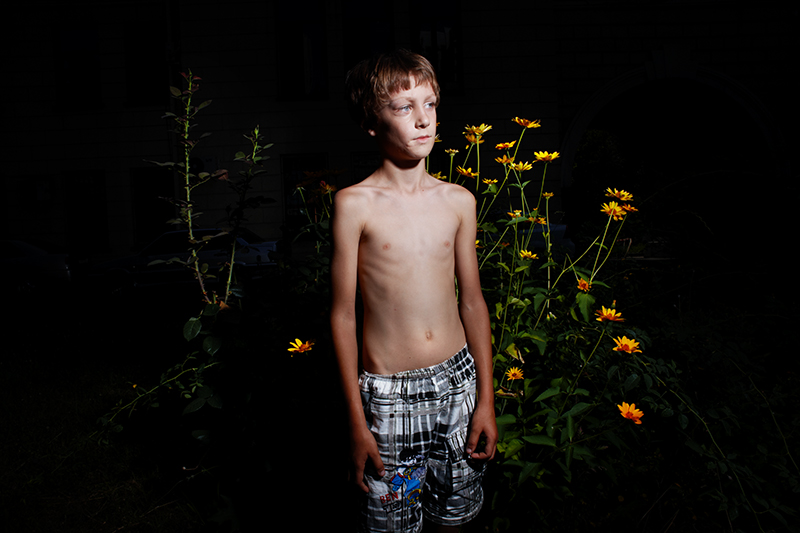
STATEMENT by curator Victoria Ivanova
FRACTURE & HEALING
Despite the need to question first impressions, the instinctive reaction at the face of a new encounter may reveal what an invested gaze may suppress. Ansett’s immediate response to Donetsk was that he arrived to “a city caught in a flux between the lingering hangover of the Soviet past and the seduction of the mythology of Europe’s free market.” Building on his existing interest in the rise of individualism in societies whose appetites have started to exceed common sense, the artist states that ironically what he misses most within his own society is what Ukraine seems to dislike most about itself: “Donetsk should not be too quick to reject completely some of the benefits of an ideology that celebrates the power of the collective” given that a sense of social cohesion and common belonging may be what is needed to move forwards more constructively. Speaking of how this insight is reflected in his Donetsk series, Ansett comments: “The images form a collective – but of individuals existentially placed. This is not a narrative observation of the person – placed in fragmented spaces, it is a further exploration of the isolation brought by the new sense of individualism.”
The placement and arrangement of works in a warehouse that just about escaped destruction in an extensive fire, attempts to reinforce the logic of solitary individuals sharing a seemingly difficult reality which should become the common ground for co-existence. As Richard Ansett points out, “reality is a complex space, we can view the exact same landscape with joy or complete despair but the space remains the same.” One of the halls of Warehouse №2 is transformed to create a church-like atmosphere with luminous images aligned along both sides of the nave leading up to an altar-piece. The sanctuary-feeling encourages solidarity and faith based on the commonality of our experience. The aesthetics of light-boxes alludes to the stained-glass windows in cathedrals through which the light traditionally associated with the divine spirit shines through. Here the luminosity emanates from the flesh of each individual emphasising that the sacred is to be found at the foundation of our being, and in unison we have the power to illuminate and transform what appears as a dark and a hopeless reality.
The six images of individuals with physical injuries taken in the gardens of one of Donetsk’s hospitals make a direct reference to human beings’ inherent fragility. While it is clear that injuries and traumas are inflicted upon us through interaction with the outside world, Ansett conveys that healing can only come from within, as we emerge from denial and understand the power of our agency and internal resources. Ansett explains: “In the hospital gardens, the use of flowers partly represents the fertility of the Ukrainian soil, exploited throughout history by East and West. The subjects here are injured but ultimately full recovery will come only from within Ukraine itself.” The image of a young boy looking straight onto the viewer with a knowledge and wisdom that seem to be beyond his years, and whose physical injury is not immediately obvious.
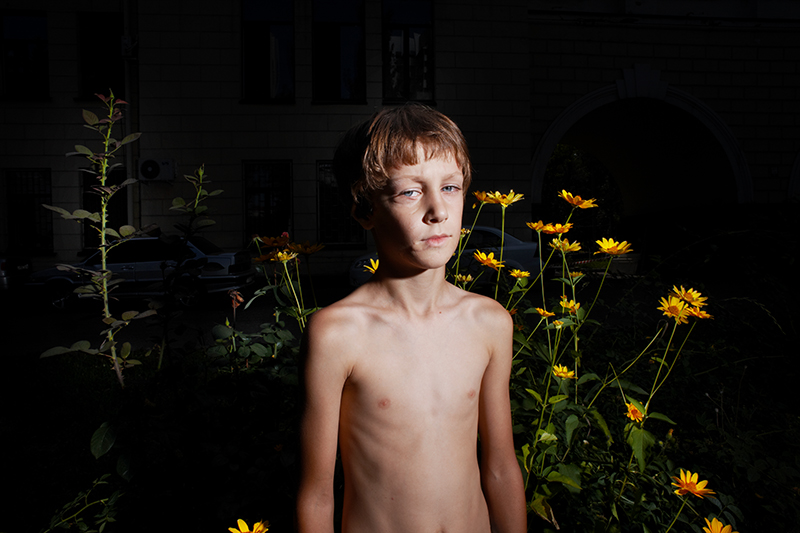
STATEMENT by curator Victoria Ivanova
FRACTURE & HEALING
Despite the need to question first impressions, the instinctive reaction at the face of a new encounter may reveal what an invested gaze may suppress. Ansett’s immediate response to Donetsk was that he arrived to “a city caught in a flux between the lingering hangover of the Soviet past and the seduction of the mythology of Europe’s free market.” Building on his existing interest in the rise of individualism in societies whose appetites have started to exceed common sense, the artist states that ironically what he misses most within his own society is what Ukraine seems to dislike most about itself: “Donetsk should not be too quick to reject completely some of the benefits of an ideology that celebrates the power of the collective” given that a sense of social cohesion and common belonging may be what is needed to move forwards more constructively. Speaking of how this insight is reflected in his Donetsk series, Ansett comments: “The images form a collective – but of individuals existentially placed. This is not a narrative observation of the person – placed in fragmented spaces, it is a further exploration of the isolation brought by the new sense of individualism.”
The placement and arrangement of works in a warehouse that just about escaped destruction in an extensive fire, attempts to reinforce the logic of solitary individuals sharing a seemingly difficult reality which should become the common ground for co-existence. As Richard Ansett points out, “reality is a complex space, we can view the exact same landscape with joy or complete despair but the space remains the same.” One of the halls of Warehouse №2 is transformed to create a church-like atmosphere with luminous images aligned along both sides of the nave leading up to an altar-piece. The sanctuary-feeling encourages solidarity and faith based on the commonality of our experience. The aesthetics of light-boxes alludes to the stained-glass windows in cathedrals through which the light traditionally associated with the divine spirit shines through. Here the luminosity emanates from the flesh of each individual emphasising that the sacred is to be found at the foundation of our being, and in unison we have the power to illuminate and transform what appears as a dark and a hopeless reality.
The six images of individuals with physical injuries taken in the gardens of one of Donetsk’s hospitals make a direct reference to human beings’ inherent fragility. While it is clear that injuries and traumas are inflicted upon us through interaction with the outside world, Ansett conveys that healing can only come from within, as we emerge from denial and understand the power of our agency and internal resources. Ansett explains: “In the hospital gardens, the use of flowers partly represents the fertility of the Ukrainian soil, exploited throughout history by East and West. The subjects here are injured but ultimately full recovery will come only from within Ukraine itself.” The image of a young boy looking straight onto the viewer with a knowledge and wisdom that seem to be beyond his years, and whose physical injury is not immediately obvious.
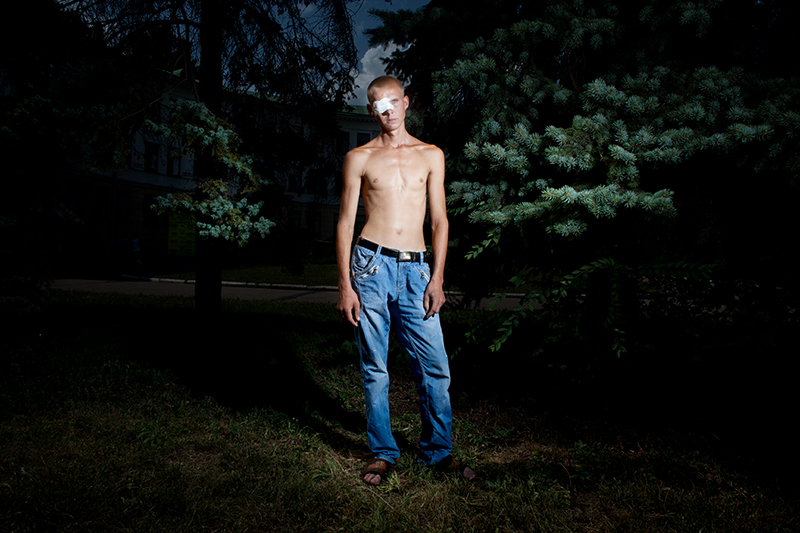
STATEMENT by curator Victoria Ivanova
FRACTURE & HEALING
Despite the need to question first impressions, the instinctive reaction at the face of a new encounter may reveal what an invested gaze may suppress. Ansett’s immediate response to Donetsk was that he arrived to “a city caught in a flux between the lingering hangover of the Soviet past and the seduction of the mythology of Europe’s free market.” Building on his existing interest in the rise of individualism in societies whose appetites have started to exceed common sense, the artist states that ironically what he misses most within his own society is what Ukraine seems to dislike most about itself: “Donetsk should not be too quick to reject completely some of the benefits of an ideology that celebrates the power of the collective” given that a sense of social cohesion and common belonging may be what is needed to move forwards more constructively. Speaking of how this insight is reflected in his Donetsk series, Ansett comments: “The images form a collective – but of individuals existentially placed. This is not a narrative observation of the person – placed in fragmented spaces, it is a further exploration of the isolation brought by the new sense of individualism.”
The placement and arrangement of works in a warehouse that just about escaped destruction in an extensive fire, attempts to reinforce the logic of solitary individuals sharing a seemingly difficult reality which should become the common ground for co-existence. As Richard Ansett points out, “reality is a complex space, we can view the exact same landscape with joy or complete despair but the space remains the same.” One of the halls of Warehouse №2 is transformed to create a church-like atmosphere with luminous images aligned along both sides of the nave leading up to an altar-piece. The sanctuary-feeling encourages solidarity and faith based on the commonality of our experience. The aesthetics of light-boxes alludes to the stained-glass windows in cathedrals through which the light traditionally associated with the divine spirit shines through. Here the luminosity emanates from the flesh of each individual emphasising that the sacred is to be found at the foundation of our being, and in unison we have the power to illuminate and transform what appears as a dark and a hopeless reality.
The six images of individuals with physical injuries taken in the gardens of one of Donetsk’s hospitals make a direct reference to human beings’ inherent fragility. While it is clear that injuries and traumas are inflicted upon us through interaction with the outside world, Ansett conveys that healing can only come from within, as we emerge from denial and understand the power of our agency and internal resources. Ansett explains: “In the hospital gardens, the use of flowers partly represents the fertility of the Ukrainian soil, exploited throughout history by East and West. The subjects here are injured but ultimately full recovery will come only from within Ukraine itself.” The image of a young boy looking straight onto the viewer with a knowledge and wisdom that seem to be beyond his years, and whose physical injury is not immediately obvious.
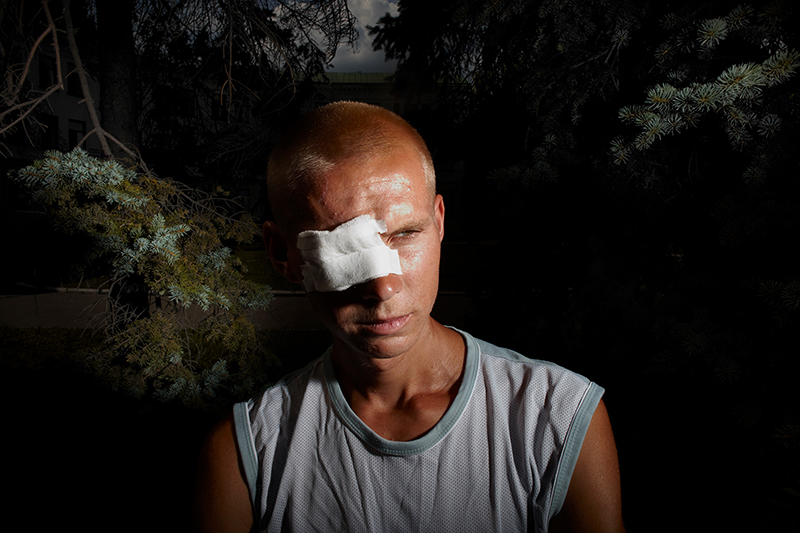
STATEMENT by curator Victoria Ivanova
FRACTURE & HEALING
Despite the need to question first impressions, the instinctive reaction at the face of a new encounter may reveal what an invested gaze may suppress. Ansett’s immediate response to Donetsk was that he arrived to “a city caught in a flux between the lingering hangover of the Soviet past and the seduction of the mythology of Europe’s free market.” Building on his existing interest in the rise of individualism in societies whose appetites have started to exceed common sense, the artist states that ironically what he misses most within his own society is what Ukraine seems to dislike most about itself: “Donetsk should not be too quick to reject completely some of the benefits of an ideology that celebrates the power of the collective” given that a sense of social cohesion and common belonging may be what is needed to move forwards more constructively. Speaking of how this insight is reflected in his Donetsk series, Ansett comments: “The images form a collective – but of individuals existentially placed. This is not a narrative observation of the person – placed in fragmented spaces, it is a further exploration of the isolation brought by the new sense of individualism.”
The placement and arrangement of works in a warehouse that just about escaped destruction in an extensive fire, attempts to reinforce the logic of solitary individuals sharing a seemingly difficult reality which should become the common ground for co-existence. As Richard Ansett points out, “reality is a complex space, we can view the exact same landscape with joy or complete despair but the space remains the same.” One of the halls of Warehouse №2 is transformed to create a church-like atmosphere with luminous images aligned along both sides of the nave leading up to an altar-piece. The sanctuary-feeling encourages solidarity and faith based on the commonality of our experience. The aesthetics of light-boxes alludes to the stained-glass windows in cathedrals through which the light traditionally associated with the divine spirit shines through. Here the luminosity emanates from the flesh of each individual emphasising that the sacred is to be found at the foundation of our being, and in unison we have the power to illuminate and transform what appears as a dark and a hopeless reality.
The six images of individuals with physical injuries taken in the gardens of one of Donetsk’s hospitals make a direct reference to human beings’ inherent fragility. While it is clear that injuries and traumas are inflicted upon us through interaction with the outside world, Ansett conveys that healing can only come from within, as we emerge from denial and understand the power of our agency and internal resources. Ansett explains: “In the hospital gardens, the use of flowers partly represents the fertility of the Ukrainian soil, exploited throughout history by East and West. The subjects here are injured but ultimately full recovery will come only from within Ukraine itself.” The image of a young boy looking straight onto the viewer with a knowledge and wisdom that seem to be beyond his years, and whose physical injury is not immediately obvious.
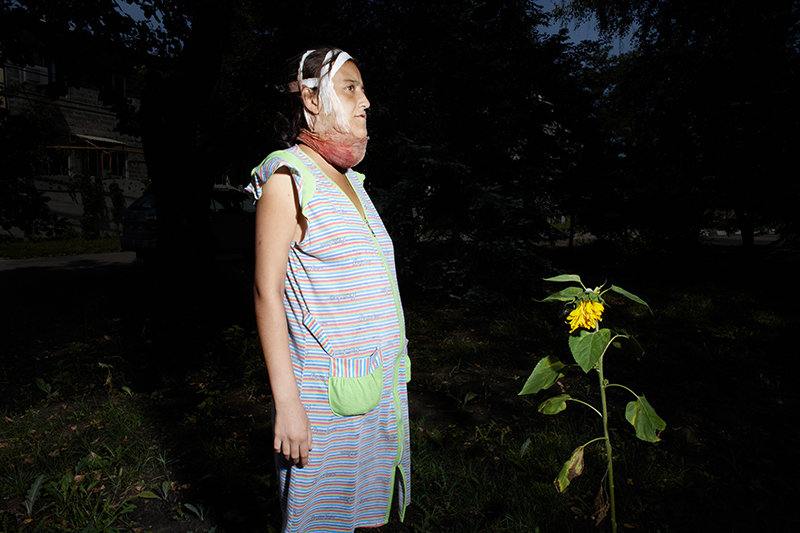
STATEMENT by curator Victoria Ivanova
FRACTURE & HEALING
Despite the need to question first impressions, the instinctive reaction at the face of a new encounter may reveal what an invested gaze may suppress. Ansett’s immediate response to Donetsk was that he arrived to “a city caught in a flux between the lingering hangover of the Soviet past and the seduction of the mythology of Europe’s free market.” Building on his existing interest in the rise of individualism in societies whose appetites have started to exceed common sense, the artist states that ironically what he misses most within his own society is what Ukraine seems to dislike most about itself: “Donetsk should not be too quick to reject completely some of the benefits of an ideology that celebrates the power of the collective” given that a sense of social cohesion and common belonging may be what is needed to move forwards more constructively. Speaking of how this insight is reflected in his Donetsk series, Ansett comments: “The images form a collective – but of individuals existentially placed. This is not a narrative observation of the person – placed in fragmented spaces, it is a further exploration of the isolation brought by the new sense of individualism.”
The placement and arrangement of works in a warehouse that just about escaped destruction in an extensive fire, attempts to reinforce the logic of solitary individuals sharing a seemingly difficult reality which should become the common ground for co-existence. As Richard Ansett points out, “reality is a complex space, we can view the exact same landscape with joy or complete despair but the space remains the same.” One of the halls of Warehouse №2 is transformed to create a church-like atmosphere with luminous images aligned along both sides of the nave leading up to an altar-piece. The sanctuary-feeling encourages solidarity and faith based on the commonality of our experience. The aesthetics of light-boxes alludes to the stained-glass windows in cathedrals through which the light traditionally associated with the divine spirit shines through. Here the luminosity emanates from the flesh of each individual emphasising that the sacred is to be found at the foundation of our being, and in unison we have the power to illuminate and transform what appears as a dark and a hopeless reality.
The six images of individuals with physical injuries taken in the gardens of one of Donetsk’s hospitals make a direct reference to human beings’ inherent fragility. While it is clear that injuries and traumas are inflicted upon us through interaction with the outside world, Ansett conveys that healing can only come from within, as we emerge from denial and understand the power of our agency and internal resources. Ansett explains: “In the hospital gardens, the use of flowers partly represents the fertility of the Ukrainian soil, exploited throughout history by East and West. The subjects here are injured but ultimately full recovery will come only from within Ukraine itself.” The image of a young boy looking straight onto the viewer with a knowledge and wisdom that seem to be beyond his years, and whose physical injury is not immediately obvious.
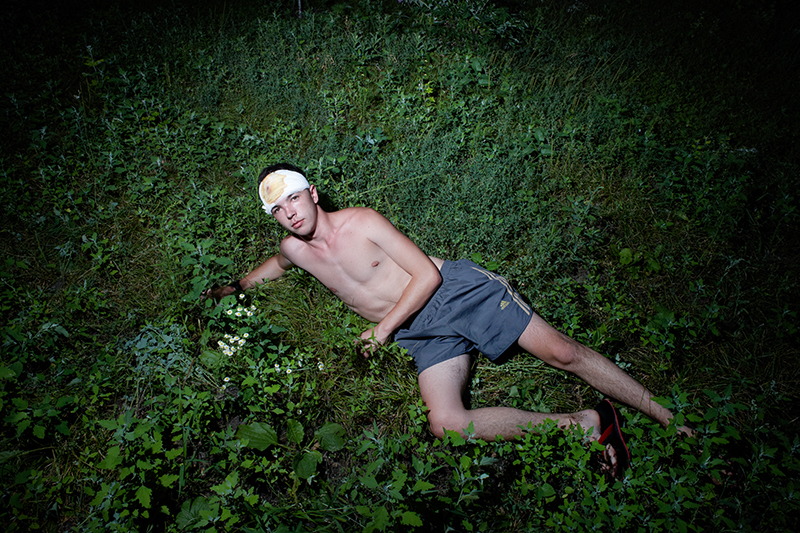
STATEMENT by curator Victoria Ivanova
FRACTURE & HEALING
Despite the need to question first impressions, the instinctive reaction at the face of a new encounter may reveal what an invested gaze may suppress. Ansett’s immediate response to Donetsk was that he arrived to “a city caught in a flux between the lingering hangover of the Soviet past and the seduction of the mythology of Europe’s free market.” Building on his existing interest in the rise of individualism in societies whose appetites have started to exceed common sense, the artist states that ironically what he misses most within his own society is what Ukraine seems to dislike most about itself: “Donetsk should not be too quick to reject completely some of the benefits of an ideology that celebrates the power of the collective” given that a sense of social cohesion and common belonging may be what is needed to move forwards more constructively. Speaking of how this insight is reflected in his Donetsk series, Ansett comments: “The images form a collective – but of individuals existentially placed. This is not a narrative observation of the person – placed in fragmented spaces, it is a further exploration of the isolation brought by the new sense of individualism.”
The placement and arrangement of works in a warehouse that just about escaped destruction in an extensive fire, attempts to reinforce the logic of solitary individuals sharing a seemingly difficult reality which should become the common ground for co-existence. As Richard Ansett points out, “reality is a complex space, we can view the exact same landscape with joy or complete despair but the space remains the same.” One of the halls of Warehouse №2 is transformed to create a church-like atmosphere with luminous images aligned along both sides of the nave leading up to an altar-piece. The sanctuary-feeling encourages solidarity and faith based on the commonality of our experience. The aesthetics of light-boxes alludes to the stained-glass windows in cathedrals through which the light traditionally associated with the divine spirit shines through. Here the luminosity emanates from the flesh of each individual emphasising that the sacred is to be found at the foundation of our being, and in unison we have the power to illuminate and transform what appears as a dark and a hopeless reality.
The six images of individuals with physical injuries taken in the gardens of one of Donetsk’s hospitals make a direct reference to human beings’ inherent fragility. While it is clear that injuries and traumas are inflicted upon us through interaction with the outside world, Ansett conveys that healing can only come from within, as we emerge from denial and understand the power of our agency and internal resources. Ansett explains: “In the hospital gardens, the use of flowers partly represents the fertility of the Ukrainian soil, exploited throughout history by East and West. The subjects here are injured but ultimately full recovery will come only from within Ukraine itself.” The image of a young boy looking straight onto the viewer with a knowledge and wisdom that seem to be beyond his years, and whose physical injury is not immediately obvious.
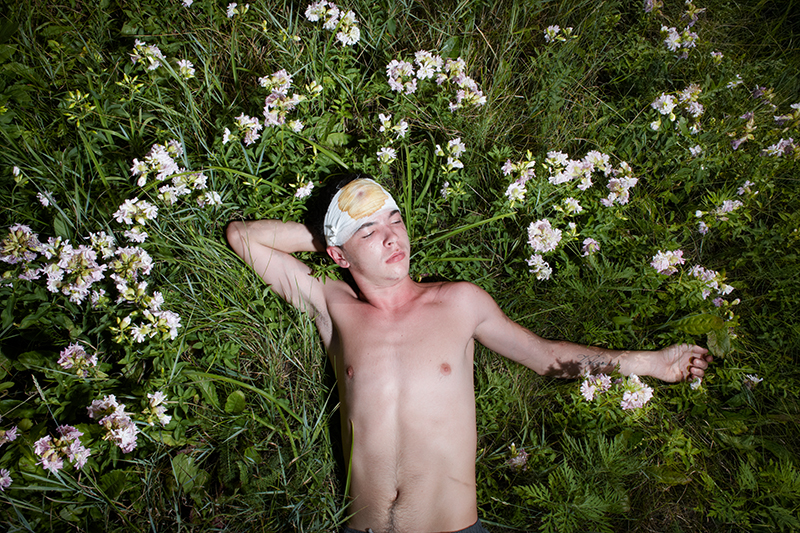
STATEMENT by curator Victoria Ivanova
FRACTURE & HEALING
Despite the need to question first impressions, the instinctive reaction at the face of a new encounter may reveal what an invested gaze may suppress. Ansett’s immediate response to Donetsk was that he arrived to “a city caught in a flux between the lingering hangover of the Soviet past and the seduction of the mythology of Europe’s free market.” Building on his existing interest in the rise of individualism in societies whose appetites have started to exceed common sense, the artist states that ironically what he misses most within his own society is what Ukraine seems to dislike most about itself: “Donetsk should not be too quick to reject completely some of the benefits of an ideology that celebrates the power of the collective” given that a sense of social cohesion and common belonging may be what is needed to move forwards more constructively. Speaking of how this insight is reflected in his Donetsk series, Ansett comments: “The images form a collective – but of individuals existentially placed. This is not a narrative observation of the person – placed in fragmented spaces, it is a further exploration of the isolation brought by the new sense of individualism.”
The placement and arrangement of works in a warehouse that just about escaped destruction in an extensive fire, attempts to reinforce the logic of solitary individuals sharing a seemingly difficult reality which should become the common ground for co-existence. As Richard Ansett points out, “reality is a complex space, we can view the exact same landscape with joy or complete despair but the space remains the same.” One of the halls of Warehouse №2 is transformed to create a church-like atmosphere with luminous images aligned along both sides of the nave leading up to an altar-piece. The sanctuary-feeling encourages solidarity and faith based on the commonality of our experience. The aesthetics of light-boxes alludes to the stained-glass windows in cathedrals through which the light traditionally associated with the divine spirit shines through. Here the luminosity emanates from the flesh of each individual emphasising that the sacred is to be found at the foundation of our being, and in unison we have the power to illuminate and transform what appears as a dark and a hopeless reality.
The six images of individuals with physical injuries taken in the gardens of one of Donetsk’s hospitals make a direct reference to human beings’ inherent fragility. While it is clear that injuries and traumas are inflicted upon us through interaction with the outside world, Ansett conveys that healing can only come from within, as we emerge from denial and understand the power of our agency and internal resources. Ansett explains: “In the hospital gardens, the use of flowers partly represents the fertility of the Ukrainian soil, exploited throughout history by East and West. The subjects here are injured but ultimately full recovery will come only from within Ukraine itself.” The image of a young boy looking straight onto the viewer with a knowledge and wisdom that seem to be beyond his years, and whose physical injury is not immediately obvious.